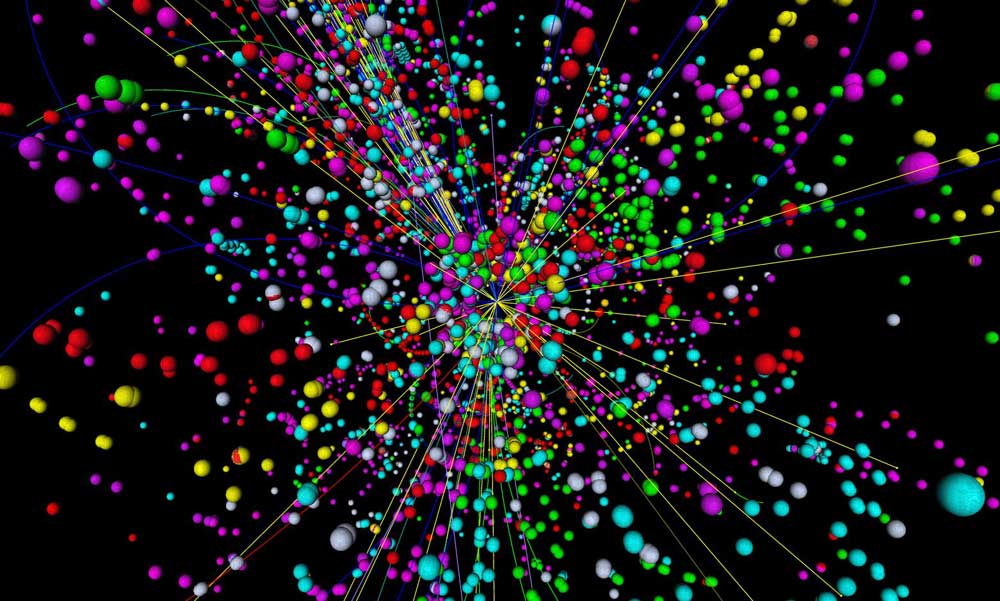Exotic Particles, Tiny Extra Dimensions May Await Discovery

LONDON — Exotic particles never before detected and possibly teensy extra dimensions may be awaiting discovery, says a physicist, adding that those searching for such newbies should keep an open mind and consider all possibilities.
Such particles are thought to fill gaps in, and extend, the reigning theory of particle physics, the Standard Model, said David Charlton of the University of Birmingham in the United Kingdom, who is also a spokesperson of the ATLAS experiment at the world's biggest particle accelerator, the Large Hadron Collider (LHC), and one of the experiments that pinpointed the Higgs boson particle thought to explain why other particles have mass.
Charlton addressed an audience of researchers last month at a talk titled "Before, behind and beyond the discovery of the Higgs Boson" here at the Royal Society. [Beyond Higgs: 5 Elusive Particles That May Lurk in the Universe]
"The questions raised by the discovery of the Higgs boson suggest new physics, and new particles, may be near to hand, at the energies now — and soon — being probed at the LHC," he said. Such questions, he said, include: why is the Higgs boson so light; and why does the Standard Model have such difficulty explaining physics that occurs at masses higher than that of the Higgs boson, to name a couple.
The LHC, housed in a 17-mile-long (27 kilometers) circular, underground tunnel at CERN near Geneva, Switzerland, smashes protons together at near light speed. The resulting collisions release huge amounts of energy in the form of particles — possibly new, exotic ones.
At the moment, the particle accelerator is switched off so that an upgrade can be made. However, it will start hunting for new particles again in 2015, smashing protons together at its maximum energy of 14 TeV, or terra electron volts.
Which theory?
Get the world’s most fascinating discoveries delivered straight to your inbox.
Before they wake up the LHC from its nap, scientists are busy putting together an extensive program of searches for new particles that could validate one or another extension to the reigning theory of particle physics — the Standard Model.
Because it is impossible to know for certain what these hypothetical particles would be, researchers will look at many and varied collision types, "hunting in numerous ways for deviations in the data from the background expectations from known processes," said Charlton. (Physicists know what distributions should result from the formation of various known particles, so if they see a deviation from these expectations, they can hypothesize that a new particle has been detected.)
An extension to the Standard Model is necessary to shed light on the remaining mysteries of the universe, such as the nature of dark matter, the elusive particles that are thought to account for about 85 percent of all the matter in the universe.
Many have hailed supersymmetry, a theory that posits every known particle in the universe has a yet-undiscovered and much heavier sister particle, as the main candidate for an extension. However, the LHC's failure to produce any proof of supersymmetric particles has prompted a number of scientists to look elsewhere for evidence of new physics.
"Supersymmetry is a great idea, but there's no experimental evidence for it at this stage," said Charlton. "It's just one of the possibilities for physics beyond the Standard Model, and it has some elegant math properties so it tends to be favored. But there's a range of other models that could also help to explain some of the problems that we see with the Standard Model."
One popular alternative to supersymmetry proposes the idea of extra dimensions. [5 Reasons We May Live in a Multiverse]
Scientists suspect extra dimensions exist in space and time; these dimensions are microscopic, proponents say, making them tricky for detectors to pick up. "But as we go to very high energies with the LHC, maybe we'll start to see evidence of extra dimensions," said Charlton. Such evidence would come in the form new particles, or perhaps missing energy as some particles move off in dimensions other than the ones people can see. Such extra dimensions are needed in string theory, which suggests that tiny strings replace sub-atomic particles.
Another idea suggests that the particles that have already been found are not actually fundamental, meaning they have a sub-structure composed of even smaller particles. And then there is string theory, which suggests tiny strings replace subatomic particles.
Searching for 'something'
But physicists should not simply be searching for evidence to support one theory or another, Charlton said. Rather, it is important "to look at every rare process we can that might be a signal for some new physics showing up. We have to study each one and see if it's consistent with our expectations."
If LHC fails to detect any signs of new physics, the only way forward is scaling up to higher-energy collisions and more intense beams. "There could be a model that we haven't thought of yet," said Charlton.
And it is this possibility of "something out there that researchers haven't thought of yet and that would explain all the mysteries" that is the most exciting, said physicist Ben Allanach of the University of Cambridge, adding, "Of course, if I could think of that, I'd be working on that."
To spot this "something," physicists must look for high-energy particles in many different ways and many different configurations, and see whether the data is consistent with the expectations, or if there's something that perhaps isn't predicted by any of the existing models, Charlton said.
"We really have to try to be as open as possible and try to leave no stone unturned in looking at all the possibilities," said Charlton.
Follow us @livescience, Facebook & Google+. Original article on LiveScience. Follow the author on Twitter @SciTech_Cat.


